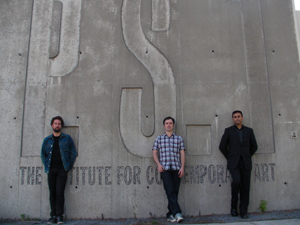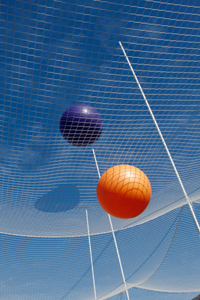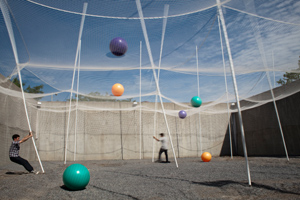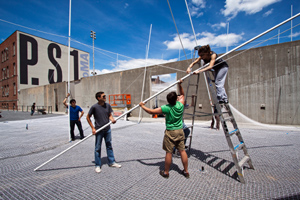Sound Art Seduces at MoMA PS1: The Making of Pole Dance
LONG ISLAND CITY, QUEENS: Being an artist has never been a very sound proposition, in New York City or anywhere else. So it follows that an immersion into sound art would be twice as risky.
Fortunately in our day and age, there’s a little infrastructure – grants and friendly facilities — to be found for the daring sorts who expand the boundaries for everyone else. Through the end of September, the pioneering spirit is in evidence courtesy of the Museum of Modern Art (MoMA) Young Architects Program (YAP),taking the form of the larger-than-life installation Pole Dance at PS1 in Long Island City.
Officially described as a “summer-long outdoor social space project comprised of both physical and virtual components that questions the relationship between body and structure,” Pole Dance yet again shows that seeming simplicity can have its complexities under the surface. A dynamic, physical installation that occupies the P.S.1 courtyard, it presents visitors with an interconnected system of 30-foot-tall 2-inch glass fiber poles set in a 16-foot by 16-foot grid — connected by bungee cords, they gently sway in response to the wind and the interaction of the audience to create continuous ripples of movement and sound.
Working in conjunction with MoMA and architects Solid Objectives Idenburg Liu (SO-IL), who were awarded the YAP commission this year, global conglomerate Arup turned its SoHo-based Acoustics division loose on the project. The head of Arup Acoustics, Raj Patel, took inspiration from the proposed project’s ideas of waves, movement and vibration, and suggested that the movements be converted to sound and visuals as a fundamental component of the installation. SO-IL was sold on the idea, resulting in a new wrinkle for sound art that can amuse your mind in person or live via the iPhone if you can’t be there – take your pick.
Patel, along with Arup Music, Arts and Multimedia Consultant Mike Skinner and Arup Acoustic Consultant Terence Caulkins spearheaded development and implementation of the project. This is a very smart contingent bridging sonics and science in the name of progress, and they laid their souls bare for SonicScoop on how a sound art installation of this scale came together in LIC.
What was the directive that Young Architects laid out for this installation and how did Arup help translate this vision into what became Pole Dance?
Patel: We were given lots of room to be creative. It was important to the architects that the technology be as discrete as possible and also that the sounds be harmonious with the environment. But aside from these rather general parameters they were very open. Interactivity and ease of use were also key concerns for SO-IL. They wanted to be sure our component integrated into the overall installation seamlessly, which I think we achieved really nicely.
The people I’ve met at Arup Acoustics seem to be admirably passionate about art and engineering at the same time. This seems like it was a lot of work — what did you want to get out of the project, and what did you want audiences/participants to get out of it?
Skinner: I wanted to contribute to the overall ambience and most importantly, fun! PS1’s courtyard is a unique place in the world in terms of both the audience that it attracts and, as importantly, the freedom the curators and staff give artists to experiment. I think So-IL’s concept was pretty genius in that it encouraged the audience to interact with the installation in a multitude of ways.
Caulkins: Before moving to New York I was involved in the design of 3D audio systems for live concerts and virtual reality applications in France (gaming, psycho-acoustic research, cognitive psychology research), and got a chance to work with a number of artists on their sound installations at the Pompidou Center in Paris, France. Since then it’s been my objective to get more involved in the creation and composition of sound installations.
When Raj approached Mike and I with the concept of an interactive sound installation I was naturally very excited. From an audience perspective, the objective was to create a sonic atmosphere that would soothe and blend harmoniously into the existing soundscape, and invite visitors to explore the space of the installation. Adding a sound component to SO-IL’s project was also a way to get visitors physically involved with the architecture, and heighten their sense of connection to the installation.
Moving on the “where” — what made PS1 a compelling venue for creating this installation?
Skinner: I’ve always wanted to do an installation in the courtyard at PS1 since moving to the city 15 years ago. It’s such an unusual, large, contained space that it’s ideal for sound. Well, ideal may be pushing it since the subway station nearby is one of the loudest I’ve ever heard, and there’s lots of street noise, but as long as those factors are considered in the design they’re not really problematic.
PS1 is unique in the way the museum staff really gives you the run of the place. It’s like – “You want the scissor lift – there it is. Need to cut a pipe? Try the saw over there. And try not to hurt anyone.” I like a work environment like that.
Caulkins: I’ve been fan of PS1 for a while now; when I used to visit the city before living in NY, it was always the first stop on my tour of the museums. I love the look and feel of the PS1 building, with its public school atmosphere and its creepy basement. I’ve also appreciated the quality of the artistic programming in the museum over the years. Being part of a project at MoMA PS1 was therefore, on some level, a dream come true!
The outdoor portion has a very active soundscape, dominated mostly by the screeching trains. In this context it was a challenge to compose a piece that could grab people’s attention and invite them to play the installation, while maintaining a seamless sense of harmony with the existing environment.
Musically, can you describe the method and effect of “playing” Pole Dance as an instrument? What’s the relationship between music and sound here?
Caulkins: Eight of the poles installed in the small courtyard contain accelerometers which pick up movements of the poles and transmit this information to a custom interface created for the installation. When someone shakes one of the poles, the back and forth motion alerts the system that something is happening — motion sensing — and the system triggers the playback of a simple mix of sine tones on the nearest loudspeaker.
These tones are modulated in real time according to the rate of acceleration of the poles. Someone shaking the pole slowly and deliberately will create a slow deliberate modulation. Someone shaking quickly and vigorously will create a quick and vigorously modulated tone! This simple relationship between movement and sound is designed to help the listener understand that the pole is an instrument. They can then explore new ways of interacting with the network of poles, for instance by moving the central pole to affect more than one accelerometer at a time.
The sine tones associated to each of the poles have been composed with deliberate harmonic relations. As visitors shake the poles, the balance is temporarily modified and local dissonances are introduced. The underlying harmonic structure helps maintain a harmonious feel to the installation; it ties the sonic result together. I like to think that this design is a reflection of how the netting ties the network of poles together in the physical installation– it offers stability and connectivity to the network of poles; without it the entire structure would collapse into “architectural dissonance” i.e. a pile of poles on the ground.
OK, that’s HEAVY. And to anyone who thinks that sounds really complicated, it’s a lot easier to understand when you experience it! On the virtual side of things, why was it important to develop an accompanying iPhone app?
Patel: Artists are working more and more with sound, especially as the technology becomes more accessible in the home. Connecting sound to visuals provides a powerful way of engaging people, especially the young, creates tactile immersive experiences, and connects a digital experience to a real-world one.
The Website and iPhone app were a way of bringing all of this together. Sound art is still not fully mainstream: It has yet to entice collectors in the same way as visual art. That made the idea of coupling the two even more important – it makes the art more accessible and attractive to collectors. All the data from the movement of the poles will be captured over the entire period of the installation. This means that the installation can have a visual life, by re-interpreting and re-visualizing the data, for many years to come. It also gives the opportunity to create unique visual or audio art works from the data.
Skinner: The iPhone app was developed by 2×4 in close collaboration with Arup and Solid Objectives. It was important conceptually in that it added yet another layer of interactivity to the installation, giving the users a bit of an expanded role to contribute to the sounds they are making. I think it’s fairly unusual for museum-goers to be afforded to opportunity to actually change/play with an artwork. The hope was to let the visitors become more engaged with the piece since they could contribute to it in a non-trivial way.
Additionally, the graphic interfaces 2×4 created are interesting because they visually represent the movement of the poles which I think makes the relationship between the motion and the sound more conspicuous.
Moving from the conceptual to the actual, you guys really got your fingernails dirty with this project: What were the surprises when it came to actually installing Pole Dance, and then maintaining it?
Skinner: As I mentioned, one of our directives was to minimize the amount of technology visible to the audience. Achieving this, especially with a budget that didn’t allow for hiring additional labor, entailed quite a lot of time running cables, hanging speakers, digging trenches for the cables and generally trying to make evidence of our work disappear as much as possible. The funny part is that I think we were quite successful at making the technology less visible, so in the end it may look like it was quite easy. I can tell you though that it was a lot of very physical work.
As for maintenance, we’ve had some of our sensor cables break during the Saturday parties. This would be bothersome if it weren’t for the fact that these parts are often broken because people are playing them so enthusiastically. So I haven’t minded making the repairs very much.
It’s a good problem to have, as they say. So what are the rewards and challenges of creating an art installation? And what would you say is the biggest thing you learned from creating this installation that you can carry over to the next project?
Skinner: The reward of all of arts projects in general is the satisfaction of seeing people experience sound and art in a new way. This project in particular was especially gratifying in that it is a large scale piece that is very accessible to people of all ages. I’ve seen 2-year- olds playing the poles, which makes all the work seem worth it.
Caulkins: I definitely learned from this project. Though we put a good deal of effort into the planning phase, a number of unforeseen challenges came up that needed creative solutions. Some of these have to do with the fact that the installation engages a physical interaction with the audience, hence broken poles, damaged sensors, etc…
Other challenges have arisen from the fact that the installation is up and running outside, and therefore exposed to heat, wind, rain, and other hazards. Part of our design work was getting things to hold up in these conditions. We also had to develop solutions to get the installation to run on museum hours, and maintenance itself like automatic rebooting of the central computer on a regular basis [to prevent it from slowing down due to constant data crunching]. All of these “real-world” based developments are now part of a toolbox that I’ll carry into the next project.
In NYC, we like to think that we’re the capital of the art world. How easy or hard is it to develop ambitious installations like Pole Dance here?

(l-r) Mike Skinner, Terence Caulkins, and Raj Patel of Arup Acoustics onsite at PS1 (photo credit: Milena Mepris)
Skinner: I don’t know that NYC is really the most vibrant place for the arts these days — the city has changed so that the places for making and creating art are becoming increasingly rare. When I moved here 15 years ago the only high heels you’d see in the Meat Packing District were on tranny-hookers and I couldn’t get a cab to drive me to Williamsburg. There were obviously some downsides to that, but the upside was that there were lots of nooks to experiment, make noise, live cheap and make work. I have to say that I miss that.
Caulkins: I hear what Mike is saying, and I’ve heard it a lot from my old-school New York friends. I’ve only been in the city for about three years; my point of reference is Paris, with its established and sometimes seemingly impermeable art scene. From a creative perspective, I have had a much easier experience here in New York. Since I moved here, I have not stopped meeting and collaborating with amazingly creative, hard-working and resourceful people.
I sometimes talk about the feeling I used to get on vacation here, that there was a kind of ectoplasmic energy oozing out of the ground that would cause me stay up and walk around at all hours of the night, eager to find out about everything that was going on. Now that I live here I find it essential to give this energy a creative outlet, and I’ve found it easy to find like-minded individuals interested in creating music and working on projects that try to push the envelope. So, though it may be true that NYC has changed and become a more sterile version of itself over the years, I believe it still has a good share of dirty nooks left in which artistic experimentation will continue to flourish.
That’s a relief! And we completely agree. Finally, art installations seem to live on the fringe , but they have some pretty essential functions. Why do you think projects like Pole Dance are important — for people to create, and for people to experience?
Skinner: Of course! I remember standing on the subway platform at Herald Square when I first moved to New York and coming across Christopher Janney’s sound installation. I remember that moment very clearly and it probably encouraged me to explore that world in some way. If our work on Pole Dance has that effect on a few people, it makes it even more gratifying than just the satisfaction of making the piece.
Caulkins: This kind of project is a great opportunity to change the way people look at their environment. Going forward, it’s probable that we will be seeing more and more interactivity in public spaces as sensor and control technologies continue to evolve and become more robust and affordable to integrate into in the built environment. I think this will encourage people to explore their environment and become more implicated in the spaces they live in. It will also hopefully inspire non-artists to explore the creative process — and get them into making their own art.
— David Weiss
Please note: When you buy products through links on this page, we may earn an affiliate commission.










